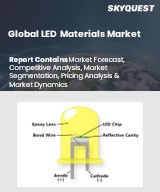
Report ID: SQMIG25E2120

Report ID:
SQMIG25E2120 |
Region:
Global |
Published Date: April, 2024
Pages:
199
|
Tables:
88 |
Figures:
72
Global LED Materials Market size was valued at USD 15.32 billion in 2022, USD 16.90 billion in 2023 and is projected to grow USD 33.56 billion by 2031, growing at a CAGR of 10.3% in the forecast period (2024-2031).
A light-emitting diode (LED) emits light when power passes through it. Photons are produced in a semiconductor when electrons recombine with electron holes. The color of the light is determined by the energy required for electrons to pass the band gap of the semiconductor (equal to photon energy). Several semiconductors can be combined to produce white light, or a semiconductor can be covered with a phosphor that emits light. LEDs provide several benefits over incandescent light sources, such as lower power consumption, longer lifespan, greater physical resilience, smaller size, and faster switching. Some drawbacks of LEDs are lower maximum working and storage temperatures; electrical limitations to low voltage and generally to DC (not AC) power; and difficulties to generate steady lighting from a pulsating DC or AC electrical supply source.
As more people adopt cutting-edge technologies like the Internet of things (IoT), automation, and cameras, the use of LED materials is expanding in applications such as high-definition television displays, cameras, camcorders, telecommunications, optical fibre communication, and TV remote controls. The market is evaluated comprehensively in the study on the global market for LED materials. The study provides a thorough examination of the market's major segments, trends, drivers, constraints, competitive environment, and other elements that are significantly influencing it. The LED stays stable when there is no voltage applied to it because no electrons or holes can pass through. Upon applying the voltage, the LED becomes forward biassed, causing electrons from the N-region and holes from the P-region to flow towards the active area.
Our industry expert will work with you to provide you with customized data in a short amount of time.
REQUEST FREE CUSTOMIZATIONWant to customize this report? This report can be personalized according to your needs. Our analysts and industry experts will work directly with you to understand your requirements and provide you with customized data in a short amount of time. We offer $1000 worth of FREE customization at the time of purchase.

Report ID: SQMIG25E2120